Ocracoke & the Battle of the Atlantic
For some, learning that German u-boats were patrolling the waters off the East Coast during World War II is something new, especially when they discover The Battle of the Atlantic began in 1939, two years before the United States entered the war.
A series of events took place that directly impacted the Outer Banks of North Carolina during the conflict, though those events were unforeseen at the time agreements and acts were signed between the United States and Great Britain. Locally, one of our most direct connections to the Battle of the Atlantic occurred on May 11, 1942, when HMT Bedfordshire was torpedoed and sunk off Cape Lookout.
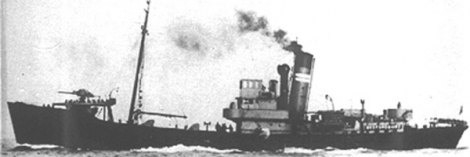
Before we get into what happened and why, I think it’s important to note from where much of this information came. In January of this year, I received an email from an Englishman named Michael Westhead. He contacted me for information about the British Cemetery and the 2017 ceremony and reception. Through our communications I learned he served in the Royal Merchant Navy as a young man in the early 1960’s. We talked about the relationship between Great Britain the United States and I told him I was born and lived in Bedfordshire, England. Upon learning of my unique connection to Ocracoke, Michael assembled two booklets. One was his memoir of his time in the British Merchant Navy; the other contained information about two agreements our countries entered during World War II. This second booklet contained details I hadn’t previously known and some information in that booklet will be included in this article.
Michael also sent me a narrative history, Trawlers Go To War, which details the successes and tragedies experienced by the Royal Navy Patrol Service (RNPS) during WWII. Sailors who served contributed to the book, providing great insight through the sharing of personal experiences. He then sent a photographic history book, The Blitz, which contains refurbished photographs taken during the air raids that took place in London and around Great Britain. Before we delve into the history, it’s necessary to acknowledge that the information Michael provided in the booklets was compiled by his own research, and I may not have known about many of the events that occurred between 1939 and 1942 had it not been for his research and willingness to compile the booklets and give me Trawlers go to War and The Blitz.
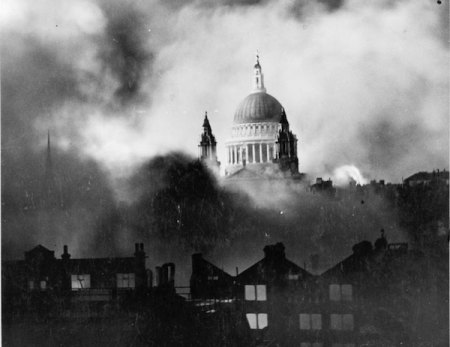
The general attitude of the U.S. government and citizens at the time the Second World War began was that the country should stay out of the conflict. It’s a time – much like before our involvement in World War One – when the world referred to the United States as being an Isolationist nation. Years before the United States became involved in land, air, and naval combat in WWII we struck two deals with Great Britain. The first of these deals was the Destroyer Transfer Agreement.
Before the legislation was signed, the U.S. government passed the Neutrality Act, the aim of which was to prevent the country from entering any more foreign wars. Taken from the University of Houston, “Between 1935-1937, Congress passed three separate neutrality laws that clamped an embargo on arms sales to belligerents, forbade American ships from entering war zones and prevented them from being armed, and barred Americans from traveling on belligerent ships.” Much of the language stemmed from trade agreements that many critics believed were meant to benefit American bankers and munitions traders during World War One. The whole concept came about because of these criticisms and also because the U.S. didn’t want to become involved in another foreign war.
Once war broke out in Europe in 1939, Great Britain faced several serious campaigns with Germany: The Battle of the Atlantic (1939-1945), The Battle of Britain (July 1940 - October 1940), and The Blitz (September 7, 1940 - May 11, 1941). The Battle of Britain and The Blitz were campaigns which overlapped, but the targets and tactics were different in each. Great Britain defeated the Germans during The Battle of Britain – an aerial battle where Royal Air Force (RAF) and ground defenses were targeted – and because Great Britain downed so many German aircraft, Hitler decided not to attempt a land invasion. But the nation was still facing naval warfare in the Atlantic, and was just beginning to experience relentless bombings, called the Blitzkrieg (Lightning War) or The Blitz, on many of the nation’s cities. Hitler’s sole intent of The Blitz was to cause fear, chaos, and absolute terror among British citizens.
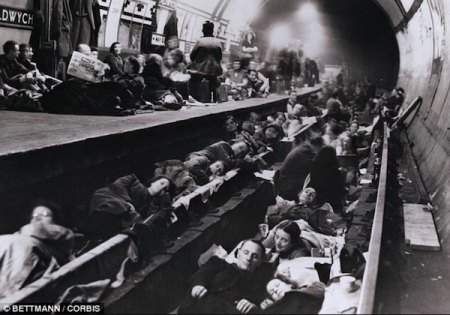
While aerial combat was occurring, Ambassador Joseph P. Kennedy – father of later President John F. Kennedy – reported the surrender of Great Britain to the Germans was “inevitable.” He also recommended the U.S. to align with Germany, but Churchill, hoping to persuade Roosevelt to send American destroyers, warned that if Britain fell, colonial islands close to American shores could be a direct threat to the United States if Germany was victorious. The Royal Air Force and the Luftwaffe engaged in air battle over Great Britain and by August and September of 1940, Britain “stood alone” against Germany. The Luftwaffe had been relentlessly bombing London, killing citizens and destroying factories. The Blitz went on in London for 55 consecutive nights. To see images of The Blitz and the devastation, follow this link: https://m.youtube.com/watch?v=3XA2gJ5r7hE&feature=youtu.be
Finally the United States – through Secretary of State Cordell Hull – agreed to send Great Britain 50 destroyers. Signed into law in September of 1940 by British Prime Minister Winston Churchill and U.S. President Franklin Delano Roosevelt, the Destroyer Transfer Agreement gave Great Britain ownership of 50 battleships and destroyers the U.S. owned and used during World War One. 43 of these ships went to the British Royal Navy; seven went to the Royal Canadian Navy. Many of these ships were in awful condition and were equipped with outdated and non-functioning weaponry. In return, Great Britain gave land to the United States so we could establish navy bases and airfields, all of which were established as 99-year rent-free lease agreements. The land for these bases was all located in various locations which were still part of the British Commonwealth.
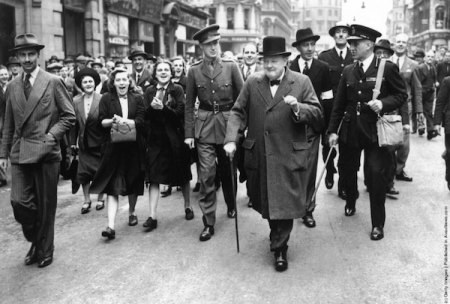
The next agreement to aid the Allies was signed into law on March 11, 1941. The Lend-Lease Act gave President Roosevelt power to “sell, transfer, exchange, or lend equipment to any country to help it defend itself against the Axis Powers.” $50 billion was appropriated by Congress for the Lend-Lease Act and was divided amongst 38 countries, with Great Britain receiving $31 billion. Over the next several years Britain repaid $650 million – almost half of the total “debt” – to the United States. Along with the repayment, Great Britain was also required to hand over to the United States technological advancements such as Radar, antibiotics, jet aircraft, and advanced nuclear research, as well as any rights and royalties Great Britain held over any other innovations.
Before the Lend-Lease Act was signed, Hitler switched tactics and the Luftwaffe began bombing industrial, port, and coastal cities throughout Great Britain. The aerial assault of London ended on May 11, 1941, but the bombings and terror tactics utilized by the Germans were far from finished. Pilotless rockets and incendiary bombs were dropped on the city, and later, in 1942, Germany began bombing a series of tourist cities, which were all selected from a travel guide. Germany’s attempts to demoralize the citizens failed. Hitler’s intention was to cause so much damage the people of Britain would urge the government to surrender. The bombings had the complete opposite effect, and the people of Britain carried on with their lives as much as possible, and would not give up.
During this time, The Battle of the Atlantic still posed a threat to the Allies, the goods the U.S. was shipping them, and Great Britain’s ability to ship supplies in and out. Then, on December 7, 1941, the Imperial Japanese Navy Air Service attacked the U.S. base located at Pearl Harbor, Hawaii. The United States was instantly thrust into the war in the Pacific, and in the days following, Germany declared war.
With our naval capabilities severely disabled after the attack at Pearl Harbor, the U.S. forged an alliance with Great Britain which resulted in mutual assistance. The Royal Navy Patrol Service (RNPS) and Royal Navy Volunteer Reserve (RNVR) had been involved in naval warfare since war began in 1939. Many of the men who enlisted were skilled fishermen, while others who joined had little or no maritime experience. The men went to a training facility in the coastal town of Lowestoft, England where they were taught to use and maneuver the vessels and weaponry, and given their service assignments. These newly-trained naval personnel manned fishing trawlers which were converted and armed to serve as anti-submarine (A/S) vessels, 24 of which were sent to the United States’ East Coast in the spring of 1942. Their mission: to assist our own navy with protecting the U.S. from potential German invasions, escort tankers and merchant vessels carrying supplies, and sink u-boats. These vessels were also equipped with an early form of Radar, and they were loaned to the United States Navy by Great Britain. Often, these trawlers were the first victims of torpedoes from German u-boats, and losses were heavy.
One of these converted trawlers was HMT Bedfordshire. Commissioned in 1935, Bedfordshire was used as a fishing boat in her first few years. When the British Admiralty declared ownership of the vessel in 1939, she was equipped with guns with the purpose being to sink u-boats, though her other roll was to escort tankers up and down the East Coast.
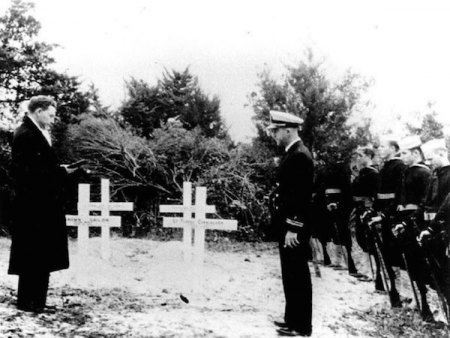
HMT Bedfordshire arrived in Morehead City, North Carolina in March of 1942. Before March, she had been on patrols along the eastern seaboard, predominantly off the Outer Banks from Currituck to Lookout Shoals. On April 18, 1942, Bedfordshire’s crew assisted the United States Navy in searching for survivors from u-85, the first u-boat sunk by the U.S. Navy. After four days of searching with no survivors found, the rescue mission was ended, and Bedfordshire – having served as a guard for the U.S. Navy – returned to patrolling the waters off Currituck Island, Hatteras Island, Ocracoke Island, and Lookout Shoals.
On May 1, Bedfordshire was sent out to locate a life boat that had been spotted about 225 nautical miles (259 miles) off Cape Lookout. With no luck finding the lifeboat, she was back to patrolling the normal area between May 7 and May 9, then she returned to Morehead City.
On May 10, u-558 had been spotted off Cape Lookout. That night, HMT Bedfordshire and HMT St Loman left Morehead City in search of the vessel. The trawlers located the u-boat, which fired at St Loman, but she was able to evade the German torpedo. Then, u-558 turned its attention to Bedfordshire. In the early hours of May 11, 1942, she was struck by two torpedoes and sank almost immediately. All 37 men onboard were killed.
On May 14, 1942, the bodies of four sailors presumed to be from HMT Bedfordshire washed ashore on Ocracoke. Navy Special Investigator Aycock Brown – who was widely known as a photographer and journalist – identified the bodies of Sub-lieutenant Thomas Cunningham and Ordinary Telegraphist Stanley Craig.
Prior to the May 11 sinking, while HMT Bedfordshire was docked at Morehead City, Sub-lieutenant Cunningham had welcomed Aycock Brown aboard the vessel. Brown had traveled there to deliver British flags to Cunningham for the burial of four sailors, and brought with him two extra.
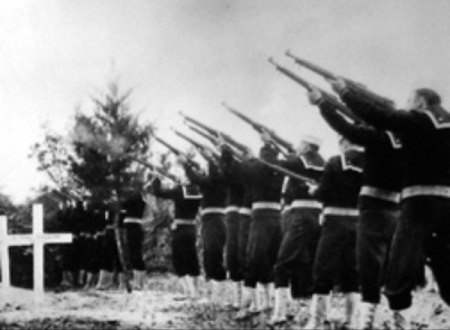
After the vessel was sunk and the bodies of four sailors were discovered, the British Cemetery on Ocracoke was created by residents. Brown attended the burial and placed the two remaining flags on the caskets of Sub-lieutenant Cunningham and Ordinary Telegraphist Craig before they were buried. Land for the cemetery was either donated to or purchased by Great Britain and is maintained by the United States Coast Guard and local volunteers. The Museum of the Graveyard of the Atlantic and its British War Graves committee organize the ceremony along with the U.S.C.G and volunteers. The ceremony and reception occur on the Friday closest to May 11. This year the events will be held on May 12, beginning at 11:00am. All are welcome to attend.
“If I should die, think only this of me;
That there’s some corner of a foreign field that is forever England.”
-From The Soldier by Rupert Brooke (1887-1920)



